After the death of Józef Piłsudski, there was a discussion about his burial. Everyone was unanimous about the place - the Wawel Royal Castle. After the Pope's consent and the settlement of all organizational issues, the Marshal's body was laid to rest in the crypt of St. Leonard. Nobody expected a nationwide conflict that broke out after the coffin was moved to another crypt ...
Range and power of the so-called The Wawel conflict surprised everyone - the dispute involved state and church authorities at the highest levels, the press, radio, as well as various secular and Catholic organizations. How did it happen?
Death of the Marshal
President of the Republic of Poland prof. Ignacy Mościcki announced this evening the following message:“To the citizens of the Republic of Poland! Marshal Piłsudski ended his life. With the great difficulty of his life, he built strength in the nation, with a genius of mind, with a hard effort of will, he resurrected the State. ["Głos Narodu", May 12, 1935]
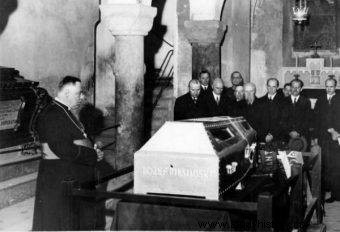
Commemorating Józef Piłsudski at his sarcophagus in Wawel in 1935.
Piłsudski died on May 12, 1935 in the Belweder Palace. National mourning was announced in the country. A day later, an autopsy was performed and the heart and brain were removed from the body. Doctors Major Wiktor Kaliciński and Józef Laskowski worked on mummification. The Marshal's brain was analyzed at the Polish Institute of Brain Research in Vilnius (a monograph on this subject was published after its completion).
On May 13 and 14, Piłsudski's body was exposed to the public. On May 15, the body was taken to the cathedral of St. John and placed on a catafalque in the nave. The coffin was made of silver according to the design of prof. Wojciech Jastrzębowski. On May 17, a funeral mass was celebrated, and in the afternoon a military parade was organized in Pola Mokotowskie in honor of the deceased.
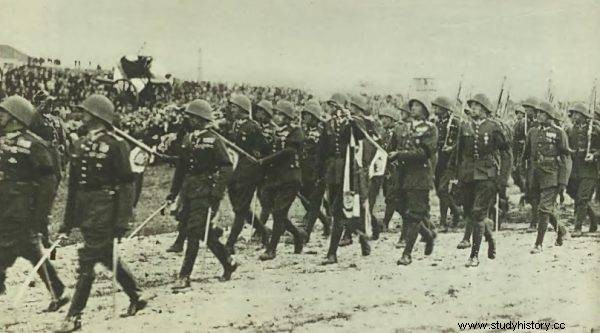
An army parade in front of Józef Piłsudski's coffin in the Mokotów field in Warsaw.
After the ceremony, the coffin was moved to the railway platform (even a separate track was prepared and built!). It was lit, and a guard was put up next to it - two cavalrymen and six generals. A special railway train set off on a journey to Krakow. It lasted all night, because the train traveled slowly, to allow the citizens gathered on the route to say goodbye to the Marshal. Preparations for the funeral and the ceremony itself became an occasion to manifest the idea of unity in the nation.
By train to the funeral
The cult of Józef Piłsudski flourished and grew stronger during all the celebrations. The apogee of this phenomenon took place on the day of the funeral on the Wawel Hill. On May 18 in the morning, a train with a coffin arrived in Kraków (several carriages, including sleeping and personal cars for the immediate family and guests, as well as an 18-meter-long tow truck with a coffin and a cannon). Earlier, representatives of the government came to the capital of Małopolska. The great interest in the funeral caused a blockage at the train station, which translated into a delay in the celebration.
The coffin was transported in a ceremonial procession to St. Mary's Church. The track stretched for several kilometers , mainly on Lubicz, Basztowa, Dunajewskiego and Floriańska streets (it could have been estimated at 100,000 people; representatives of the authorities, army, education, and the inhabitants of Krakow).
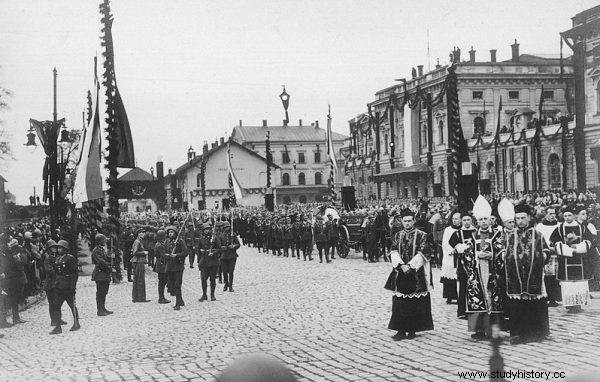
Funeral procession on the streets of Krakow.
After 10 a.m. in St. Mary's Basilica, Archbishop Adam Sapieha celebrated the mass. Then, along Wiślna, Straszewskiego and Podzamcze streets, the funeral procession went to Wawel. There the coffin was placed in the crypt of St. Leonard. The Sigismund bell rang along with a salvo of cannons (101 shots fired).
Start of conflict
More than two years after the ceremonial funeral of Piłsudski, Archbishop Adam Sapieha ordered the coffin with the Marshal's body to be moved from the crypt of St. Leonard to the crypt under the Tower of Silver Bells, causing a nationwide conflict. What was the cause of it?
We have to go back to 1916. It was then that Ignacy Jan Paderewski asked for Henryk Sienkiewicz to be buried in Wawel; However, Archbishop Sapieha did not consent. Eleven years later, the remains of Juliusz Słowacki were brought from Paris to Poland. Archbishop Sapieha, persuaded by Piłsudski, agreed to the burial, but made a reservation that it would be the last such funeral at Wawel. He wrote:"(...) then Marshal Piłsudski, as Prime Minister, wrote to me, asking for it and agreeing that these bodies would be the last to be buried there."
However, Piłsudski in his will suggested the place of his burial - and it was Wawel . After the Marshal's death, the Council of Ministers began to put pressure on Archbishop. Sapieha to allow the funeral. And that's how it happened. But it also had "side effects." Fr. Kazimierz Figlewicz, vicar of the Wawel parish, recalled:
Due to the constant arrival of various delegations and banners, the cathedral became the vestibule of the crypt. Various people and relationships came - sometimes foreign to us by religion - and entered the crypt with their banners (...). From the so-called trains of popular people, sometimes drunk people came to the crypt, who in a way that did not bid with the seriousness of the place and the majesty of death expressed their sorrow for the death of the late Marshal.
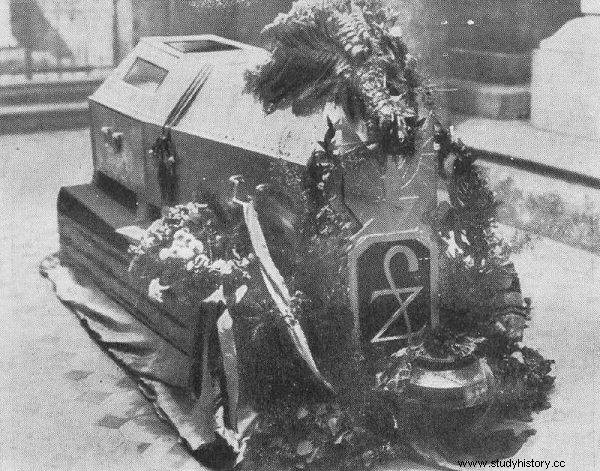
Coffin with the body of Józef Piłsudski after the mass in Krakow.
Why, according to Fr. Figlewicz, the main nave of the cathedral became the vestibule to the crypt? Well, the coffin with Piłsudski's body was placed in the crypt of St. Leonard, the only entrance to which is from inside the cathedral; anyone wishing to pay tribute to the Marshal had to pass through the nave.
It should be mentioned that Archbishop Sapieha, allowing Piłsudski to be buried at Wawel, agreed to place the coffin in the crypt of St. Leonard only temporarily - until a separate crypt is prepared (which could be accessed directly from the outside). Anyway, the crypt of St. Leonard did not have ventilation and adequate heating. In November 1935, Archbishop Sapieha tried to obtain information about the planned transfer of Piłsudski's body into a metal coffin (the humidity in the crypt was too high, and the crystal coffin was not suitable for such harsh conditions), but to no avail.
The authorities acted sluggishly. Fr. Figlewicz recalled that for this reason medical commissions were often held, during which the Marshal's corpse was taken from the coffin, all garments were stripped, and then subjected to additional mummification procedures . The smell of the medical supplies used was supposedly unbearable and lingered in the cathedral for several days. In 1937, Archbishop Sapieha wrote:
When this spring. I returned to the country and found out privately that the Committee had no intention of moving the Marshal's body to a new crypt, and I guessed, which was later found out, that the proper intention of these circles was to leave them in the crypt of St. Leonard (...).
Crypt under the Silver Bell Tower
The target crypt for the body of Józef Piłsudski - under the Silver Bells Tower - was prepared and checked personally by Archbishop. Sapieha. In his notes, however, he stated that even if he had issued an official letter related to the transfer of the body, he would not have received a reply. Why was he so anxious to move the coffin?
He argued the legitimacy of this operation not only by poor conditions in the crypt of St. Leonard, but also the visit of the Romanian king, who, together with the president, was to pay tribute to Piłsudski. In a letter to General Bolesław Wieniawa-Długoszowski, Archbishop Sapieha wrote that the president would be received according to the church ritual, in turn "as for the king, as a schismatic man, it would be impossible . And making a difference would have unpleasant and harmful diplomatic consequences. When they enter from outside the cathedral, these difficulties will be gone. ”
The general's answer was unequivocal - there is no consent to the move. Although in subsequent letters Sapieha tried to obtain official consent (which, unfortunately, he did not succeed - even the president himself was against it), he ultimately decided on his own to transport the coffin to the crypt under the Silver Bell Tower on the night of June 22-23, 1937.
Find out more:The locomotive is playing mournfully. Funeral trains carried by heads of state
"Poland has shaken since this coffin was moved"
The movement of the body was enormous. Most politicians called this event a profanation and an insult to the majesty of the Republic of Poland. Prime Minister General Felicjan Sławoj Składkowski handed over to President Mościcki his resignation, which was not accepted. In the afternoon editions of the popular newspapers on June 23, 1937, it was in a frenzy. In "Gazeta Polska", for example, there were demands:
(...) 1) changes to the concordat, 2) puts Wawel under the direct control of the state, 3) appoints Polish bishops who feel they are faithful sons of their motherland, 4) deprivation of Fr. Metropolitan Sapieha of all honorary decorations, 5) depriving Fr. Metropolitan of Sapieha of Polish citizenship .
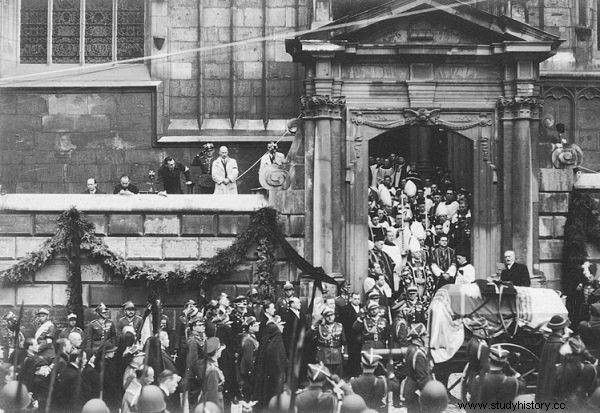
President Ignacy Mościcki's speech during the funeral ceremony in Krakow in front of the entrance to the cathedral.
The archbishop was probably in shock. He did not expect that his decision would meet with so much resistance from citizens and politicians. Protests and demonstrations were organized in the streets of the cities. Over 20,000 people gathered in front of the Saski Palace on June 25, 1937. The head of the National Unification Camp, Colonel Adam Koc, wrote in his statement on that day:“The will of the Head of State was consciously rejected. (...) I assume a protest against an unacceptable act of an individual, which violates the deep cult of the nation for an immortal Leader. "
Archbishop Sapieha was accused of violating the cult of Józef Piłsudski and of offending the president. Meanwhile, the clergyman issued an explanation for the press in which he stated that his motive was the condition of the place where the coffin was located:
Corpse, remaining in St. Leonard, damp despite the adaptations made and unprotected with a sarcophagus, were still exposed to the risk of negative consequences for the state of mummification. [The new crypt] was consecrated, as befits a Catholic tomb, before the coffin was placed there. The coffin was moved with due respect and the utmost care , in the presence of a representative of the Krakow Chapter and a delegate of the Executive Committee, who as a doctor from the very beginning supervised the condition of mummification of Marshal Piłsudski's corpse.
During the extraordinary session of the Sejm - on July 20, 1937 - Deputy Speaker of the Sejm Tadeusz Schaetzel in his speech stated that "Poland shook since the coffin was moved". It is impossible to disagree with this. On the one hand, we have President Mościcki and politicians who wanted to leave Piłsudski's coffin at all costs in one of the most honorable crypts in the vaults of the cathedral. On the other - Archbishop. Sapieha, a man for whom the enormity of people pouring over the main nave of the cathedral was unacceptable.
An additional problem was the visit of the Romanian king Charles, who was to visit Poland in the summer of 1937 - and the grave of Piłsudski. Karol professed Orthodoxy, so for Archbishop. Sapieha was inconceivable that he could visit the cathedral on a par with President Mościcki. Hence the attempt to transfer the Marshal's body as quickly as possible.
Today, it may seem that the crypt under the Silver Bell Tower is one with the cathedral, but it was not the case in the past. It served as a kind of technical and even storage base (it was part of the Austrian barracks). St. Leonard and the other rooms were the sphere of the sacred , a musty cellar later renamed a crypt - no. It is therefore not surprising that the "relocation" of Piłsudski's mortal remains to such a place aroused so much controversy.
